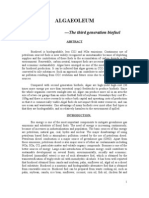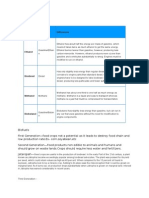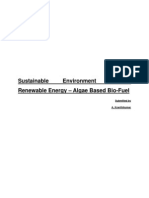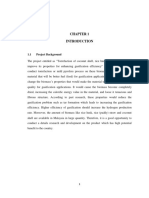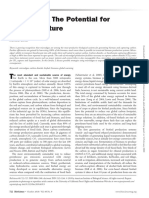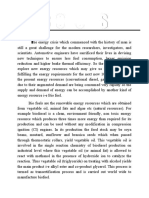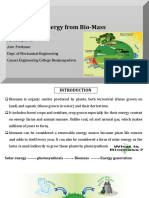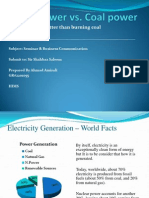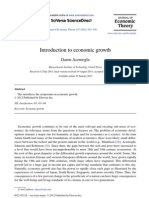Algae Photobioreactor Guide
Algae Photobioreactor Guide
Uploaded by
Peyman SazandehchiCopyright:
Available Formats
Algae Photobioreactor Guide
Algae Photobioreactor Guide
Uploaded by
Peyman SazandehchiOriginal Description:
Original Title
Copyright
Available Formats
Share this document
Did you find this document useful?
Is this content inappropriate?
Copyright:
Available Formats
Algae Photobioreactor Guide
Algae Photobioreactor Guide
Uploaded by
Peyman SazandehchiCopyright:
Available Formats
Algae Fuel
The green fuel for greener tomorrow
By SHAIKH SIRAJ MD ASKER Class: XI, Science (E/M)
College Code: 1028
What is Algae fuel?
Is
a process of using sun energy. fuel, oilgae, algaeoleum or thirdgeneration bio-fuel from algae
Algal
Bio-fuel
Vegetable
oil, bio-diesel, bio-ethanol, bio-gasoline, bio-methanol, bio-butanol
Algae Fuel Production
Why algae fuel than other biofuel?
High
yield
1. 2.
Higher than any other bio-fuel High yield range((4,700140,000 m3/km2)
Carbon
emission
1.
2.
No CO2 emission Where as other bio-fuel cause CO2 emission
Though costly but biproduct is very consumable
Cost
effective
1.
Comparative Study of different bio-fuel production
Why algae fuel than fossil fuel? Topic Fossil fuel
CO2 Emits
emission
CO2
Availabilit
Limited
y
Nature N/A Much Toxic Toxicity Bio N/A
Algae fuel Also emits CO2 but recyclable Can be produced
Yes Less,
friendly Pollution
but recoverable Not toxic
Two Success Stories
GreenFuel Technologies in Cambridge, MA is field testing a closed system that uses the CO2 in power plant fuel gases (13% of fuel gases in the test) to feed algae. Significantly reduced the CO2 concentration in the exhaust by 82.3% on sunny days and by 50.1% on cloudy days During the beta-test at the Cogeneration Plant at MIT. The process also removed 85.9% of nitrogen oxides. They estimates the cost of a fullscale system installation to be 20% to 40% less than that of a comparable SCR system (pollutant scrubbers).
Glen Kertz, president and CEO of Valcent Products, told CNN By going vertical, you can get a lot more surface area to expose cells to the sunlight. It keeps the algae hanging in the sunlight just long enough to pick up the solar energy they need to produce, to go through photosynthesis He can produce about 100,000 gallons (94,000 m3/km2) of algae oil a year per acre, compared to about 30 gallons per acre from
Process of Alga culture
Mainly 3 process
Photo
Bioreactors Loop System
Closed Open
pond
Photo Bioreactor Process
Closed Loop System
Open Pond
Benefits of Alga culture
15-300
times more than other Grows in 1-10 days Uses sunlight, CO2 and other nutrients Up to 99% of CO2 in soln can be converted No pressure on food crops No pressure on land Can be cultivated in unusable water
Potential of Algae Fuel
Multipurpose Fuel Transport Energy Jet Fuel Algae Fuel Car
How Algae fuel can help Bangladesh?
Present Condition Of Energy
Present consumption 16.6 million ton Dhaka with most pollution Huge import Government losses Not adequate supply Affecting economy Demand increasing
How Algae fuel can help
us?
Self-sufficiency No import Reduce environmental pollution Maintain balance in supply Rising economy Rising food production Reducing unemployment
A Rough Estimate 6% of area of Dhaka is under road Let , has average width 30 m If we use 1m on average on each side for algae then total area comes under cultivation is 1.216x106 m2. If we use loop system then we can grow 1.136M ton of fuel. If we do this in all the cities and towns around Bangladesh we will be almost able to meet our fuel demand
Reduce carbon Balancing Nature Fuel security Stability in supply Improve climate Better economy Peace
You might also like
- Cis Kig Api Krungsri - 240405 - 191818Document2 pagesCis Kig Api Krungsri - 240405 - 1918185h9fcn8jfjNo ratings yet
- Press MUd To Bio GasDocument5 pagesPress MUd To Bio GasAyush Agrawal100% (1)
- Loan Application FormDocument4 pagesLoan Application FormsimranNo ratings yet
- Renewable Energy ResourcesDocument117 pagesRenewable Energy ResourcesAmit AgrawalNo ratings yet
- Applied Energy: Amita Jacob, Ao Xia, Jerry D. MurphyDocument7 pagesApplied Energy: Amita Jacob, Ao Xia, Jerry D. MurphyAgustine Christela MelvianaNo ratings yet
- STUDENT ID: F04037100 NAME: 凱圖Document3 pagesSTUDENT ID: F04037100 NAME: 凱圖TekamantoaEzekielKaituNo ratings yet
- Week 12 - MicroAlgae-BiodieselDocument31 pagesWeek 12 - MicroAlgae-BiodieselAniq AmirahNo ratings yet
- ALGAEOLEUMDocument7 pagesALGAEOLEUMS Bharadwaj ReddyNo ratings yet
- Final Report CivilDocument19 pagesFinal Report CivilMaitri TanejaNo ratings yet
- Biogas For Developing Countries With Cold ClimatesDocument6 pagesBiogas For Developing Countries With Cold ClimatesTricarzet Beer100% (1)
- A Report On Bio-EthanolDocument13 pagesA Report On Bio-EthanolbukidaNo ratings yet
- Biofuel Fossil Fuel DifferencesDocument8 pagesBiofuel Fossil Fuel DifferencesmukundNo ratings yet
- Renewable Biomass A Candidate For Mitigating Global WarmingDocument13 pagesRenewable Biomass A Candidate For Mitigating Global WarmingAndreas AlvaroNo ratings yet
- BODY 1: Biomass Energy Conversion Technologies and ApplicationsDocument5 pagesBODY 1: Biomass Energy Conversion Technologies and ApplicationsHilal AltuntaşNo ratings yet
- Carbon in The Taiao ReportDocument3 pagesCarbon in The Taiao ReporttanyasquarepegsNo ratings yet
- Sustainable Environment Through Renewable Energy - Algae Based Bio-FuelDocument12 pagesSustainable Environment Through Renewable Energy - Algae Based Bio-FuelKranthi KumarNo ratings yet
- Algae Based Carbon CaptureDocument12 pagesAlgae Based Carbon CaptureHarshul KanwarNo ratings yet
- Algae Based Carbon CaptureDocument12 pagesAlgae Based Carbon CaptureHarshul KanwarNo ratings yet
- BiomassDocument3 pagesBiomassgeeturamchandani198877No ratings yet
- A Review On Algae Biodiesel A Novel Source of Renewable Energy in IndiaDocument3 pagesA Review On Algae Biodiesel A Novel Source of Renewable Energy in IndiaEditor IJRITCCNo ratings yet
- Algae Fuel Case StudyDocument5 pagesAlgae Fuel Case StudyabsinitNo ratings yet
- Final Year Report AfnanDocument57 pagesFinal Year Report AfnanJr BagaporoNo ratings yet
- Research PaperDocument9 pagesResearch PaperCody RickmanNo ratings yet
- Tannery ReportDocument6 pagesTannery ReportdevajithNo ratings yet
- Electricity Generation ProcessDocument26 pagesElectricity Generation ProcessSNEHA DEVARAJUNo ratings yet
- Biomass Is Defined As The Biological Degradable Fraction of Products, Waste and ResiduesDocument9 pagesBiomass Is Defined As The Biological Degradable Fraction of Products, Waste and Residuesadil malikNo ratings yet
- BiofuelDocument18 pagesBiofuelHamidNo ratings yet
- Microalgae: The Potential For Carbon Capture: Articles ArticlesDocument6 pagesMicroalgae: The Potential For Carbon Capture: Articles ArticlesCristian SotoNo ratings yet
- Production of Ammonia by Biomass GasificationDocument220 pagesProduction of Ammonia by Biomass GasificationAdeel Arif100% (1)
- Energy CrisisDocument8 pagesEnergy CrisisJosielyn TarsNo ratings yet
- Biomass: Biofuel (Also Called AgrofuelDocument11 pagesBiomass: Biofuel (Also Called AgrofuelApril WilliamsNo ratings yet
- Renewable and Non-Renewable Energy Resources and Energy ConservationDocument53 pagesRenewable and Non-Renewable Energy Resources and Energy Conservationwilly irawanNo ratings yet
- Biodiesel From Algae: Challenges and ProspectsDocument10 pagesBiodiesel From Algae: Challenges and ProspectsRahul KumarNo ratings yet
- Final Exam CerillanoDocument14 pagesFinal Exam Cerillanocerillanovincent8No ratings yet
- Indigenous Algae: Potential Factories For Biodiesel ProductionDocument7 pagesIndigenous Algae: Potential Factories For Biodiesel ProductionKhatlya Rivana PutriNo ratings yet
- Microalgae The Potential For Carbon CaptureDocument6 pagesMicroalgae The Potential For Carbon CaptureThanh SonNo ratings yet
- BiofuelsDocument5 pagesBiofuelsVENICE OMOLONNo ratings yet
- Bio FuelsDocument2 pagesBio FuelsZain Ul AbedinNo ratings yet
- Electricity From AlgaeDocument9 pagesElectricity From AlgaeRaghamath KaniNo ratings yet
- Research ProposalDocument12 pagesResearch ProposalSyedMmohammadKashanNo ratings yet
- Energy Resources Project Submitted To: Sir Ahmed SohailDocument18 pagesEnergy Resources Project Submitted To: Sir Ahmed SohailPeyman SazandehchiNo ratings yet
- Energy From Bio-Mass: UNIT-7Document40 pagesEnergy From Bio-Mass: UNIT-7prabhathNo ratings yet
- Waste To EnergyDocument9 pagesWaste To Energyherb089No ratings yet
- Ee Mod2@Azdocuments - inDocument19 pagesEe Mod2@Azdocuments - inmqrsr494No ratings yet
- Life Cycle Impact Assessment On ElectricDocument11 pagesLife Cycle Impact Assessment On Electricarie2000No ratings yet
- Divya Tandon and Nivedita SharmaDocument13 pagesDivya Tandon and Nivedita SharmaDianaElenaNo ratings yet
- Science ProjectDocument17 pagesScience Projecthackerabdullah696No ratings yet
- Wheat Straw Gasification by Bubbling Fluidized Bed ReactorDocument2 pagesWheat Straw Gasification by Bubbling Fluidized Bed ReactorAnonymous 4PuFzARNo ratings yet
- Sources of Energy Chapter Notes - Science Class 10 PDF DownloadDocument16 pagesSources of Energy Chapter Notes - Science Class 10 PDF DownloadlangthasabibekNo ratings yet
- Introduction To Dual Fuel InjectionDocument8 pagesIntroduction To Dual Fuel InjectionAbhiNo ratings yet
- Plant Design and Economics ProjectDocument43 pagesPlant Design and Economics Projectetayhailu100% (6)
- Awesome BiomassDocument17 pagesAwesome BiomassKristelJaneDonaireBihagNo ratings yet
- Biogas Biogas BiogasDocument32 pagesBiogas Biogas Biogasvishnu0751No ratings yet
- The Current Global Energy Supply Is Highly Dependent On Fossil Sources (Crude Oil, LigniteDocument4 pagesThe Current Global Energy Supply Is Highly Dependent On Fossil Sources (Crude Oil, LigniteUtari Agustina AchlanNo ratings yet
- EKC358 Assignment 3 VivekaDocument4 pagesEKC358 Assignment 3 VivekaViveka RamuNo ratings yet
- Hydropower Vs CoalDocument16 pagesHydropower Vs CoalAhmad LadhaniNo ratings yet
- Chap7 BiomasseDocument35 pagesChap7 Biomassefatima zahraNo ratings yet
- Biomassprm 121118090909 Phpapp01Document39 pagesBiomassprm 121118090909 Phpapp01Apri Apriyanto100% (2)
- Demystifying Climate Science: Accelerating Food & Clean Energy SecurityFrom EverandDemystifying Climate Science: Accelerating Food & Clean Energy SecurityNo ratings yet
- Airlift BioreactorDocument26 pagesAirlift BioreactorPeyman SazandehchiNo ratings yet
- Energy Resources Project Submitted To: Sir Ahmed SohailDocument18 pagesEnergy Resources Project Submitted To: Sir Ahmed SohailPeyman SazandehchiNo ratings yet
- Microbial Energy Conversion and Practical Application To An Algal Fuel CellDocument56 pagesMicrobial Energy Conversion and Practical Application To An Algal Fuel CellPeyman SazandehchiNo ratings yet
- PhotobioreactorDocument6 pagesPhotobioreactorPeyman SazandehchiNo ratings yet
- Algae BioreactorDocument41 pagesAlgae BioreactorPeyman SazandehchiNo ratings yet
- "Bioethanol From Non-Conventional Sources": José A. TeixeiraDocument34 pages"Bioethanol From Non-Conventional Sources": José A. TeixeiraPeyman SazandehchiNo ratings yet
- PhotobioreactorDocument32 pagesPhotobioreactorPeyman SazandehchiNo ratings yet
- 4 Introduction To Process Analysis and SelectionDocument250 pages4 Introduction To Process Analysis and SelectionPeyman SazandehchiNo ratings yet
- Mass Transfer RelationshipsDocument14 pagesMass Transfer RelationshipsPeyman SazandehchiNo ratings yet
- Introduction To Bioprocessing and PharmabiotechDocument34 pagesIntroduction To Bioprocessing and PharmabiotechPeyman SazandehchiNo ratings yet
- Spirulina - Spirulina Assesment and ProcespectsDocument28 pagesSpirulina - Spirulina Assesment and ProcespectsPeyman SazandehchiNo ratings yet
- Large-Scale Production of Recombinant ProteinsDocument12 pagesLarge-Scale Production of Recombinant ProteinsPeyman SazandehchiNo ratings yet
- Bioreactor ConfigurationsDocument24 pagesBioreactor ConfigurationsPeeyush Kumar100% (1)
- Lube Solvent ExtractionDocument8 pagesLube Solvent ExtractionPeyman Sazandehchi0% (1)
- LubesDocument2 pagesLubesPeyman SazandehchiNo ratings yet
- Technical Paper Series: Group II Base Stocks and Additive Response in A Hydraulic FluidDocument14 pagesTechnical Paper Series: Group II Base Stocks and Additive Response in A Hydraulic FluidPeyman SazandehchiNo ratings yet
- Nimrod and Abraham - The Two Rivals - Early Biblical PersonalitiesDocument3 pagesNimrod and Abraham - The Two Rivals - Early Biblical PersonalitiesSheni OgunmolaNo ratings yet
- ENGLISH PAPER MDCAT 2023 Prof Salman Ul WaheedDocument2 pagesENGLISH PAPER MDCAT 2023 Prof Salman Ul WaheedAfnan IjazNo ratings yet
- How To Introduce Yourself in An Interview?Document2 pagesHow To Introduce Yourself in An Interview?Mukta DengraNo ratings yet
- B.Tech S1 (R) Exam Dec 2019 (2019 Scheme) Institution Wise Pass PercentageDocument3 pagesB.Tech S1 (R) Exam Dec 2019 (2019 Scheme) Institution Wise Pass PercentageAthira RaghavanNo ratings yet
- Salvage NotesDocument4 pagesSalvage Notesroberts79100% (4)
- 2011-12 Dallas Mavericks Game Notes - April 20, 2012Document20 pages2011-12 Dallas Mavericks Game Notes - April 20, 2012Richard Cordova PinedaNo ratings yet
- FISPhil Request Letter To School PresidentsDocument13 pagesFISPhil Request Letter To School PresidentsMelcon S. LapinaNo ratings yet
- Contoh PayslipDocument7 pagesContoh Payslips5tp5kmy4yNo ratings yet
- Republic of The Philippines Department of Education Region IX, Zamboanga PeninsulaDocument3 pagesRepublic of The Philippines Department of Education Region IX, Zamboanga Peninsulasdasdasd123aNo ratings yet
- Elc AssignmentDocument10 pagesElc AssignmentNorhyasimahNo ratings yet
- Career Development: Dr. Radhika KapurDocument13 pagesCareer Development: Dr. Radhika KapurIoanaNo ratings yet
- Health Safety and Environment: Assignment 01Document7 pagesHealth Safety and Environment: Assignment 01Tanzeel M. SharifNo ratings yet
- Leading From Purpose Clarity and The Confidence To Act When It Matters Most 031641624x 9780316416245 CompressDocument226 pagesLeading From Purpose Clarity and The Confidence To Act When It Matters Most 031641624x 9780316416245 CompressangelbagatellaNo ratings yet
- Saldana v. City of Iloilo Case DigestDocument6 pagesSaldana v. City of Iloilo Case DigestVortexNo ratings yet
- Stakeholder Expectations in An Increasingly Dynamic and Complex WorldDocument12 pagesStakeholder Expectations in An Increasingly Dynamic and Complex WorldabdelmutalabNo ratings yet
- Living Shame Jamie OttDocument11 pagesLiving Shame Jamie OttladysonomaNo ratings yet
- LNG For Long Haul Transportation in India - 23052018Document3 pagesLNG For Long Haul Transportation in India - 23052018RudranilRNo ratings yet
- Nazia Tata Part TwoDocument8 pagesNazia Tata Part TwoAyush TiwariNo ratings yet
- D&D 5e Martial Addendum v0.3Document4 pagesD&D 5e Martial Addendum v0.3fishguts4ever79% (14)
- Gi I Part 2-Test 6Document3 pagesGi I Part 2-Test 6hieu432aNo ratings yet
- WGS152 Homework Help Winter 2024 7Document4 pagesWGS152 Homework Help Winter 2024 7roadhoustNo ratings yet
- Dhaka Principles & KOM LetterDocument3 pagesDhaka Principles & KOM LetterKPS Forge India Pvt. LtdNo ratings yet
- Implead Petition in MVOP-61-2016Document6 pagesImplead Petition in MVOP-61-2016Vemula Venkata PavankumarNo ratings yet
- List of The CasteDocument8 pagesList of The CasteGokilavani Muthusamy67% (3)
- Inflectional vs. Derivational MorphemesDocument2 pagesInflectional vs. Derivational MorphemesSanti Nugraha SariNo ratings yet
- Assessment Review - Corporate Finance Institute-21-40Document27 pagesAssessment Review - Corporate Finance Institute-21-40刘宝英No ratings yet
- Daron Acemoglu Introduction To Economic Growth (2012)Document6 pagesDaron Acemoglu Introduction To Economic Growth (2012)China Fcm100% (1)
- Electrical SBADocument21 pagesElectrical SBABrian Donaldson100% (1)







